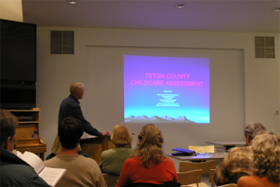|
|
|
Project
Experience |
|
| Project: |
TETON COUNTY CHILDCARE ASSESSMENT |
|
|
| Location: |
Teton, Lincoln, Sublette, and Fremont Counties, Wyoming, and Teton County,
Idaho |
|
|
|
Client: |
Teton County, Wyoming
P. O. Box 3594
Jackson, Wyoming 83001 |
|
|
| Contact: |
Sarah Mitchell, Project Manager/Grants Coordinator, Teton County |
|
|
| Year Completed: |
2005 |
|
| Project Scope:
Licensed childcare providers in
Teton County, Wyoming were experiencing growing demands for
child care and declining facility capacities. Since a
significant proportion of persons working in the Teton County
economy commute from nearby communities, Teton County, Wyoming
retained Pedersen Planning Consultants to determine future
childcare service demands for the 2006-2016 period. This
information was intended to facilitate consideration of
potential investments for the expansion and development of new
childcare facilities in Teton County, Wyoming.
|
|
| Pedersen Planning Consultants
initially analyzed demographic and economic for a five-county
area that included Teton County, Wyoming; Lincoln, Sublette and
Fremont County, Wyoming; and Teton County, Idaho. Selected
outputs from this analysis were eventually applied to the
development of a statistical model that was used to forecast
future childcare demands in the five-county study area. |
 |
|
| Childcare providers were
contacted in each of the five counties to determine childcare
enrollment data, and the type of childcare provided. Individual
interviews and a survey were used to compile this information. Representatives of various
community employers were contacted to determine anticipated
company plans that might generate significant increases or
reductions in future labor force requirements. Employer
representatives were also queried concerning the extent to which
the availability of childcare impacted their ability to recruit
or retain employees.
Childcare issues were identified
and addressed from the perspective of childcare providers,
parents using childcare services, employers, as well as family
and public health advocates. A series of childcare development
strategies were developed to facilitate the organization of a
broad-based community effort to pursue improvements to childcare
delivery, encourage greater private and public investments in
childcare facilities, and reduce barriers influencing the
financial viability of childcare operations.
Future childcare demands that
were calculated by PPC represented a forecast of the anticipated
low and high ends of anticipated demand for a 10-year period.
These forecasts established a statistical range of demand. The
development and application of a statistical model for the
project enabled PPC to consider commuter patterns, the
affordability of childcare services in Teton County, as well as
the potential motivation of commuting workers to pay the cost of
available child care. |
|
|